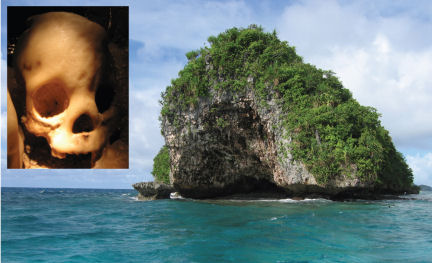Small Wonders: Tiny islanders elevate ‘hobbit’ debate
Randy Newman once jokingly sang that “short people got no reason to live.” But he never met the extinct, half-sized humans found in the South Pacific that, long after their deaths, have now entered a heated scientific debate. The debate began over a previous set of fossils found in Indonesia and hailed by their discoverers as a new species of scaled-down human ancestors.

A team led by paleoanthropologist Lee R. Berger of the University of the Witwatersrand in Johannesburg, South Africa, found thousands of human bones in two caves in Palau, Micronesia, in 2006 and 2007. These remains belonged to people who stood roughly 1 meter tall, Berger’s group estimates. Radiocarbon measurements indicate that Palau’s diminutive denizens lived between 2,900 and 1,400 years ago.
Archaeological evidence already suggested that Palau’s initial settlers arrived 3,000 years ago or slightly earlier.
No one disputes that the Palau fossils are Homo sapiens, but there is plenty of debate over whether this designation fits the Indonesian finds. The new fossils do exhibit many, but not all, of the unusual skeletal traits reported for Homo floresiensis individuals—commonly referred to as hobbits—that once lived on the Indonesian island of Flores. Palau lies about 1,200 kilometers northeast of Flores.
Palau and Flores fossils share comparably small statures, large teeth oriented at unusual angles, reduced chins, and small faces. Preliminary estimates based on cranial and facial fragments suggest that brain sizes of the Palau individuals fell at or just below the bottom of the normal range of modern human brain sizes. Hobbit brains were chimpanzee-sized.
Precise brain-size estimates for the Palau finds await the painstaking removal of hardened sediment from inside relatively complete skulls.
The new finds, described in the March PLoS ONE, don’t rule out separate species status for H. floresiensis. However, “the Palau fossils support at least the possibility that the Flores finds are simply an island-adapted population of H. sapiens, perhaps with some individuals expressing congenital abnormalities,” Berger says.
Other scientists argue that a partial Flores skeleton represents a pygmy H. sapiens with unusual traits that resulted from a genetic growth disorder, such as microcephaly (SN: 11/18/06, p. 330).
Peter J. Obendorf of RMIT University in Melbourne, Australia, and his colleagues agree. The Flores skeleton shows evidence of a nonfunctioning thyroid gland, probably because of prenatal nutritional deficiencies, Obendorf’s group suggests in a paper published online March 5 in Proceedings of the Royal Society B: Biological Sciences. This condition, known as cretinism, leads to short stature and reduced brain size.
Obendorf’s hypothesis “makes me wonder what a cretin or a microcephalic would look like in the Palau sample,” Berger says. “It might not be identical to the hobbit skeleton, but perhaps it would look a lot like it.”
No way, responds anatomist William L. Jungers of Stony Brook University School of Medicine in New York, a leading proponent of hobbits as a separate species.
H. floresiensis displays a unique body design marked by unusual limb proportions, apelike brain size, and primitive jaw, wrist, and shoulder anatomy, Jungers says.
Moreover, pygmies currently living in the Philippines and elsewhere are as small as or smaller than the “fragmentary, unassociated skeletons” from Palau, and they don’t qualify as hobbits, he adds.
No one expects the hobbit debate to cool off anytime soon, remarks anthropologist Robert B. Eckhardt of Pennsylvania State University in University Park. Still, Eckhardt says the Palau discoveries support his argument that the Flores skeleton comes from a pygmy H. sapiens with a growth disorder.







